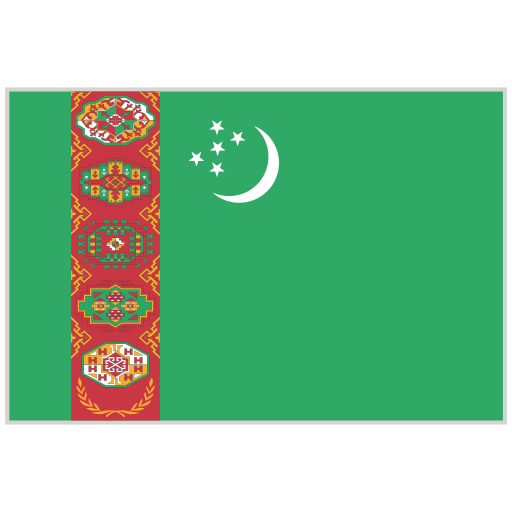.jpg) Six unassuming little trees located by the side wall of the building of the Academy of Sciences of Turkmenistan delight every year with abundant flowering and the production of compact, tart fruits, as befits a wild ancestor of fruit plants, since they belong to the “red-listed” wild pear species Boissier.
Six unassuming little trees located by the side wall of the building of the Academy of Sciences of Turkmenistan delight every year with abundant flowering and the production of compact, tart fruits, as befits a wild ancestor of fruit plants, since they belong to the “red-listed” wild pear species Boissier.
Cuttings of this rare species were once brought from the mountainous region of southwestern Turkmenistan – Magtymguly etrap of Balkan velayat – and planted right in the city center. Since then, they have adorned this corner of the capital, pleasing the scientists working there and passersby who do not even suspect that they are walking past a rare mountain plant – the wild pear, which is extremely difficult to encounter even in nature.
.jpg) Currently, except for one specimen, the trees bear fruits no larger than alcha cherry plums – the branches are generously covered with them, alongside characteristic serrated “pear-shaped” leaves. They differ significantly from the sweet juicy cultivated pears that are available from late summer to late autumn, when they become fragrant, sour-tart, and acquire a yellow-brown color. Judging by the thickness of their trunks, the trees do not appear to be more than twenty years old. Gulnabat Jumamyradova, a research associate at the National Institute of Deserts, Flora and Fauna under the Ministry of Environmental Protection of Turkmenistan, says:
Currently, except for one specimen, the trees bear fruits no larger than alcha cherry plums – the branches are generously covered with them, alongside characteristic serrated “pear-shaped” leaves. They differ significantly from the sweet juicy cultivated pears that are available from late summer to late autumn, when they become fragrant, sour-tart, and acquire a yellow-brown color. Judging by the thickness of their trunks, the trees do not appear to be more than twenty years old. Gulnabat Jumamyradova, a research associate at the National Institute of Deserts, Flora and Fauna under the Ministry of Environmental Protection of Turkmenistan, says:
.jpg) “Boissier pear is a declining mountain endemic species that occurs as part of the plant cover of the Southwestern and Central Kopetdag ranges. It is protected within the Kopetdag and Syunt-Hasardag State Nature Reserves. This species belongs to the South Hyrcanian flora — a fragment of the heritage of a previous, more humid climatic era, remnants of which have been preserved under the dry subtropical conditions in the southwestern part of the country, which forms the northern boundary of the mountain pear’s range.”
“Boissier pear is a declining mountain endemic species that occurs as part of the plant cover of the Southwestern and Central Kopetdag ranges. It is protected within the Kopetdag and Syunt-Hasardag State Nature Reserves. This species belongs to the South Hyrcanian flora — a fragment of the heritage of a previous, more humid climatic era, remnants of which have been preserved under the dry subtropical conditions in the southwestern part of the country, which forms the northern boundary of the mountain pear’s range.”
Within Turkmenistan, in addition to forms and varieties of the well-known common garden pear, wild pears also grow in nature, including the above-mentioned Boissier pear, the Turkmen pear (an endemic species), Regel’s pear, and the recently discovered willow-leaved pear by botanist-systematist Alexander Pavlenko. Over years of observation of the Ashgabat “population,” it has been noted that the plant prefers sunlight; in open areas, even the leaf length increases. At the building of the Academy of Sciences of .jpg) Turkmenistan, the trees are planted in well-lit areas, while in shaded spots their leaves begin to thin out and become dull. Interestingly, in nature, leaves at the top part of the plant, where photosynthesis occurs intensively, are larger than those in the middle or lower tiers of the crown. At the bottom, where there is much shade and nearby plants may intercept sunlight, leaves are smaller. The condition of the Ashgabat specimens is excellent, reflecting careful tending by gardeners. Planting such a tree species “close at hand” emphasizes the importance of scientific research in biodiversity conservation and the rational use of natural resources. If gardeners decide to cultivate such a tree, they should remember to water it moderately, even sparingly, and be sure to loosen the soil. This is not the first case of transplanting rare and “red-listed” plants into the bosquet area of the “scientific academic town.” Previously, this area hosted a notable plot of Professor Jumamyrat Gurbanov, a botanist, where in spring tulip kushkinsky, wild onions, and creamy bell-shaped Raddes lily flowers bloomed. In horticulture, the plant is valued as rootstock, providing cultivated pear trees with resistance to harsh conditions, diseases, and pests. Like many wild species of flora, it has high frost tolerance, drought resistance, and is undemanding regarding soil. It is also a honey plant.
Turkmenistan, the trees are planted in well-lit areas, while in shaded spots their leaves begin to thin out and become dull. Interestingly, in nature, leaves at the top part of the plant, where photosynthesis occurs intensively, are larger than those in the middle or lower tiers of the crown. At the bottom, where there is much shade and nearby plants may intercept sunlight, leaves are smaller. The condition of the Ashgabat specimens is excellent, reflecting careful tending by gardeners. Planting such a tree species “close at hand” emphasizes the importance of scientific research in biodiversity conservation and the rational use of natural resources. If gardeners decide to cultivate such a tree, they should remember to water it moderately, even sparingly, and be sure to loosen the soil. This is not the first case of transplanting rare and “red-listed” plants into the bosquet area of the “scientific academic town.” Previously, this area hosted a notable plot of Professor Jumamyrat Gurbanov, a botanist, where in spring tulip kushkinsky, wild onions, and creamy bell-shaped Raddes lily flowers bloomed. In horticulture, the plant is valued as rootstock, providing cultivated pear trees with resistance to harsh conditions, diseases, and pests. Like many wild species of flora, it has high frost tolerance, drought resistance, and is undemanding regarding soil. It is also a honey plant.
turkmenistan.gov.tm














